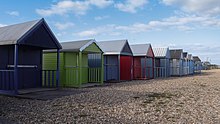This article needs additional citations for verification .(April 2019) |
| Calshot | |
|---|---|
 Buildings at the end of Calshot spit viewed across Calshot marshes | |
Location within Hampshire | |
| OS grid reference | SU47810142 |
| District | |
| Shire county | |
| Region | |
| Country | England |
| Sovereign state | United Kingdom |
| Post town | SOUTHAMPTON |
| Postcode district | SO45 |
| Dialling code | 023 |
| Police | Hampshire and Isle of Wight |
| Fire | Hampshire and Isle of Wight |
| Ambulance | South Central |
| UK Parliament | |
Calshot is a coastal village in Hampshire, England, at the west corner of Southampton Water where it joins the Solent. [1]




